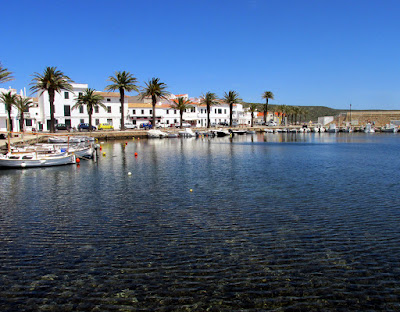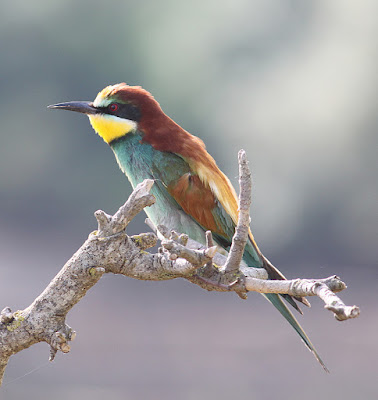Weekends are for birding but with builders in the house, there was the inevitable aftermath of the clearing up. Sunday I got stuck into the clear up operation so had to give birding a miss and now on Monday I'm painting,
So for today I’m posting pictures of the recent holiday to Menorca with a morning trip to Es Grau, the tiny fishing village on the north-east coast. "Es Grau" is not Spanish but Catalan and means "The Port"
Es Grau is home to the well-known nature reserve of S’albufera where there’s a rich variety of bird life. Sand dunes, wetlands and scrubland make up one of Menorca’s most beautiful and peaceful locations. The reserve stretches 8km north along the coast from Cap de Favaritx and contains over 100 species of birds and animals living in their natural habitat. It’s fairly important to arrive here early with a large bottle of water for the hours ahead, not to mention beating the procession of visitors, often school parties learning about their environment.
On the way there and up on roadside wires we spotted a European Roller, the only one of the two week holiday and a much sought after species. It was just a shame that the bird was above a particularly fast piece of road with no stopping places. Despite turning the car around in a gateway and looking afresh, there was nowhere to pull in for a closer look or a picture.
So we headed for the entrance gate from where around the edges of the pool and by searching hard we found 6 or more Black-crowned Night Herons, a few feeding on the tree-lined perimeter, the others just roosting in the higher branches. Here we also found a couple of Little Egrets, Black-winged Stilts, Audouin’s Gulls and Yellow-legged Gulls.
Black-crowned Night Heron
Not far from the visitor centre and watching from screen hides found many distant waterbirds, more gulls, hundreds of Coot, dozens of Little Grebe, a dozen or more Great Crested Grebe and even two Greater Flamingos. Unfortunately most of the birds remain distant on the huge expanse of water, both open and reed fringed but it’s a peaceful and relaxed environment in which to spend a morning or longer.
Hide at Es Grau
Little Grebe
Black-winged Stilt
The usual raptors were in evidence – Red Kites, Booted Eagles, Marsh Harriers and Kestrels plus a bonus in the shape of a dashing Peregrine Falcon. Peregrines aren’t numerous in Menorca but they do nest around the often rocky and remote coastline.
Along the paths we heard the purring of Turtle Doves without actually getting any really exciting or prolonged views. Similalry the Nightingales, Cetti's Warblers and Sardinian Warblers stay out of sight while proclaiming their prescence.
Turtle Dove
Purple Herons mostly remain hidden from sight as they sneak through the reeds hoping to catch unwary prey. That’s a mighty big dagger of a bill than can easily despatch a good sized Coot, Moorhen, Little Grebe or an unsuspecting frog or lizard.
Purple Heron
We encountered good numbers of Spotted Flycatchers here, not unreasonable since it is a common resident of Menorca whereby by mid to late May it’s fairly certain that migrants heading for northern Europe are long gone.
The local Spotted Flycatchers Muscicapa striata balearica are smaller, noticeably paler, and less streaked than their northern counterparts as can be seen from the pictures below, my Menorca photos from early May. For comparison, the third image is the type of Spotted Flycatcher that we see in the UK. Dutch birders are currently working on the idea that Mediterranean Spotted Flycatchers should be treated as a full and separate species, one differing from Muscicapa striata in morphology, migration and mitochondrial and nuclear DNA.
Spotted Flycatcher - Muscicapa striata balearica
Moorish Gecko was a first for me. It’s native to the Western Mediterranean region of Europe and North Africa and widely introduced to America and Asia. It is commonly observed on walls in urban environments, mainly in warm coastal areas, though it can spread inland - especially in Spain
I hope everyone enjoyed the morning in Menorca. Come evening time we decided to try a glass of Cava and a few chocolates brought all the way from Belgium by two friends and blog fans, Ivan and Jeni.
Thanks guys. the chocs sustained a little superficial damage on their long journey but after close inspection they were just fine. A lovely ending to a perfect Menorcan day.
Linking today to World Bird Wednesday .
Spotted Flycatcher - Muscicapa striata balearica
Spotted Flycatcher - Muscicapa striata - Photo credit- Ian N. White via / CC BY-NC-SA
Moorish Gecko was a first for me. It’s native to the Western Mediterranean region of Europe and North Africa and widely introduced to America and Asia. It is commonly observed on walls in urban environments, mainly in warm coastal areas, though it can spread inland - especially in Spain
I hope everyone enjoyed the morning in Menorca. Come evening time we decided to try a glass of Cava and a few chocolates brought all the way from Belgium by two friends and blog fans, Ivan and Jeni.
Belgian treats
Thanks guys. the chocs sustained a little superficial damage on their long journey but after close inspection they were just fine. A lovely ending to a perfect Menorcan day.
Linking today to World Bird Wednesday .




































































.jpeg)



.jpg)













